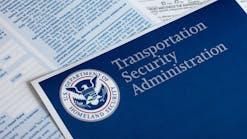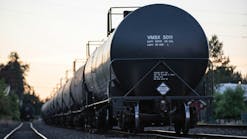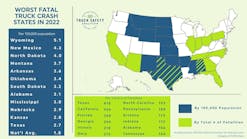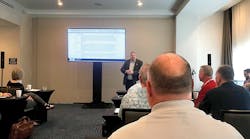FMCSA chief discusses new Drug & Alcohol Clearinghouse set to begin registrations this fall, go online in January 2020
CONGRESS asked for it, and the Federal Motor Carrier Safety Administration (FMCSA) delivered.
Nearly 30 years after the US Department of Transportation first was ordered in 1991 to implement a drug and alcohol testing program for safety-sensitive transportation employees, FMCSA—established in January 2000—finally has a central Drug & Alcohol Clearinghouse for logging positive results.
The congressionally mandated Clearinghouse (MAP-21, Section 32402), as established in a final rule published in December 2016 outlining the roles and responsibilities of those who will be required to use it, launched a website, clearinghouse.fmcsa.dot.gov, in March, and will begin registrations this fall.
Mandatory use of the Clearinghouse system is set for Jan 6, 2020.
“Here we are, 20-some-odd years later, and we are finally going to get a central repository for drug and alcohol testing,” said David Yessen, FMCSA’s compliance division chief who expounded on the new online database in a compliance update during NTTC’s 2019 Safety & Security Council Meeting.
System implementation
Creating a system to manage personally identifiable information safely and securely comes with many security and privacy concerns, and corresponding legal issues, which is one reason why FMCSA needed so much time to prepare the Clearinghouse, but it’s on track to come online as scheduled, Yessen said.
“The regulations themselves, if you look at them, are fairly short in nature, but the actual design and building of an IT system to encompass what we need to do is extremely complicated, and I don’t mean from an IT perspective,” he said. “I could take some programmers, put them in a room, tell them what we want to do, and they can develop something fairly quickly. It’s how this system interacts with everything else that becomes complicated.”
FMCSA is using only one web address for the rollout, so clearinghouse.fmcsa.dot.gov will transform into a registration site for drivers and motor carriers this fall, then morph again in January, becoming the operational Clearinghouse, which will include drivers from the US, Canada and Mexico.
“That’s when information will come into the system, with regard to drug and alcohol results,” Yessen said. “It’s where motor carriers will begin checking on drivers, and where drivers provide consent for those checks.”
Regulations for preemployment checks on drivers for drug and alcohol history will remain in effect, Yessen said, with the Clearinghouse adding an annual query requirement until 2023, when the system is fully up and running with three years of results, eliminating the paperwork piece of the check.
“We’ve got this three-year phase-in period where you’re going to be doing a little bit of both, but in 2023 the ultimate goal is no more paper, and no more sending requests to previous employers for drug and alcohol testing information and then not getting anything back,” Yessen said.
“You will strictly be doing your checking in the Clearinghouse.”
Who’s it for?
Required users include drivers who hold CDLs or commercial learner’s permits (CLPs), employers of CDL drivers who operate commercial motor vehicles, consortia/third-party administrators, medical review officers (MROs), substance abuse professionals (SAPs) and state driver’s licensing agencies.
Yessen said FMCSA is aware of approximately 500,000 motor carriers who will need to have access to the system, and it’s prepared to welcome 4 million CDL drivers, making the Clearinghouse its most accessed site—by a lot. And those are only the potential users with DOT numbers it knows about.
“That’s a lot of people who will be going in and out of the website,” he said. “So that was one of our first hurdles: How do we manage (so many) users?”
Other groups, including an “unknown number” of MROs and SAPs, also will use the system, along with CDL drivers who work in all modes of transportation within DOT—and don’t have a DOT number.
“We do have a lot of question marks when it comes to users,” Yessen said. “That’s why getting the word out, getting in there in October and getting registered, is going to be critical for everyone.”
FMCSA will leverage a General Services Administration (GSA) service to create usernames and passwords for the Clearinghouse. So, when registering this fall—October is the target month—the site will redirect users to login.gov, then send them back to the Clearinghouse to complete the process.
All drivers are not required to register, but they are encouraged to do so, Yessen said.
Once they’re in, drivers are entitled to view all information about them in the system—any time, free of charge.
“If you’ve got a driver who has no intent to leave their job, and they don’t do drugs or alcohol, then theoretically, they won’t have to get into the Clearinghouse,” he said. “We encourage them to register regardless because with a system like this, where information is going to be flowing into the system, and it’s going to be linked to a CDL, immediate notification, once that information hits the system, is going to be key.
“And unless they register and provide us with an email address, they’re going to have to wait for a letter in the mail.”
Employer registration
Employers, who will use the system to report drug and alcohol violations and run driver queries, follow the same initial steps, then validate with a DOT number. The Clearinghouse also will log test refusals and the results of anything that might occur throughout a rehabilitation program.
“If a driver is given a second chance, and they go through the SAP process, and you as the employing motor carrier give them a return-to-duty test, you’re going to have to record that negative drug test, or negative alcohol test, in the Clearinghouse as the employer of record,” Yessen said.
“It’s the only time you’re going to see a negative in the system.”
The system will accept two types of queries—limited and full. Motor carriers will be required to run limited queries on their drivers annually. These queries are only to check if a driver has information in the system, and will return a simple ‘yes’ or ‘no’ answer. Full queries provide everything in the system, eg positive tests and refusals, and must be run at the time of hire after Jan 6, 2020.
The level of driver consent required is different for each query. For limited queries, carriers need only have consent on file, indicating they have permission from the driver, and the consent can be kept on file for a designated time frame. A separate consent is required for every full inquiry.
“The luxury of a limited query is you can run batch queries unlimited,” Yessen said. “So if you’ve got 100 drivers to run, we’re giving you the ability to upload a file with all the drivers on that list and run those limited queries without having to enter every single license number and driver information.”
Once a full query is initiated, the driver will be notified an employer is looking for their information, and then the driver must go into the Clearinghouse to provide consent. If they don’t, carriers cannot hire them. If a driver receives multiple full-query requests, they’ll be able to see all of them and pick which ones to approve. Yessen also expects the Clearinghouse to be phone enabled, so a computer isn’t necessary to provide consent. Once given, a 30-day notification window is created, and carriers will be informed of any new information that enters the system during that period.
“We’re trying to make this as easy as possible,” Yessen said.
Other parties
Motor carriers will be able to designate in the Clearinghouse any third-party contractors they use for drug and alcohol compliance services. These contractors will be empowered to act on the carriers’ behalf, and they will appear on the drivers’ Clearinghouse screen as identified with that carrier.
MROs also must register to review results and transmit information with a CDL number.
“The one advantage for an MRO is that they are not carrier-reporting information, they are driver-reporting information,” Yessen said. “So they have their chain of custody in front of them, and on that chain of custody, it will need to have the CDL number and licensing state on it … because when they go to the Clearinghouse, that will be the identifier of record they will need to input.”
The Clearinghouse will help identify SAPs, who must be in the system or are ineligible for drivers to use. Once designated, the SAP will have access to that driver’s records to input critical information.
All these types of users also are likely to have assistants, who can be invited to register, then designated with specific authorities or roles within the Clearinghouse. The same goes for motor carriers.
“If the motor carrier’s organizational coordinator is the safety director, that safety director will have the ability to designate other people who have access to the Clearinghouse and can do things on behalf of the motor carrier, because we understand it’s not just one person who can log in and do things,” Yessen said.
FAQs
Q: Will violations that occurred prior to Jan 6, 2020, be reported to the Clearinghouse?
A: No, only violations that occur on Jan 6, 2020, or later.
Q: How long is the violation information retained in the Clearinghouse?
A: 5 years, unless the RTD and follow-up testing is not completed (will be retained indefinitely until follow-up testing is successfully completed).
Q: Will a prospective employer’s drug and alcohol violation history with other DOT modes be available in the Clearinghouse?
A: No, the Clearinghouse will contain only drug and alcohol program violation information for employees subject to the testing requirements under the Federal Motor Carrier Safety Regulations in 49 CFR part 382.
Q: Are employers of non-CDL drivers who operate CMVs required to query or report violations to the Clearinghouse?
A: No. Only employers who employ drivers subject to parts 382 and 383 must query or report into the Clearinghouse.
Q: How does a driver change or remove inaccurate data?
A: The driver may submit a petition via FMCSA’s DataQs system. FMCSA will review the petition (which must include the petitioner’s contact information, CDL number and state of issuance, and a detailed description of why the information is inaccurate) and notify the driver of its decision to remove, retain or correct information in the Clearinghouse and the reason for the decision. If a driver believes a petition decision was made in error, he/she may submit a request for an administrative review. The request must include an explanation of why he/she believes FMCSA made an error in their decision. The driver is informed of the decision, which constitutes the final agency action.
Q: What information may be challenged by the driver?
A: The accuracy of the information reported, and the report of employer’s actual knowledge the driver received a traffic citation for driving a CMV while under the influence of drugs or alcohol, if it did not result in a conviction. Accuracy of test results and refusals may not be challenged.
Q: s the driver’s social security number (SSN) or employee identification number (EIN) required when reporting violation information or querying the Clearinghouse?
A: No, per §382.123, the employer shall provide the driver’s CDL number and state of issuance.
Q: What information is required on the Custody and Control Form or Alcohol Testing Form?
A: The driver’s CDL number and state of issuance must be entered in lieu of the driver’s SSN or EIN.













